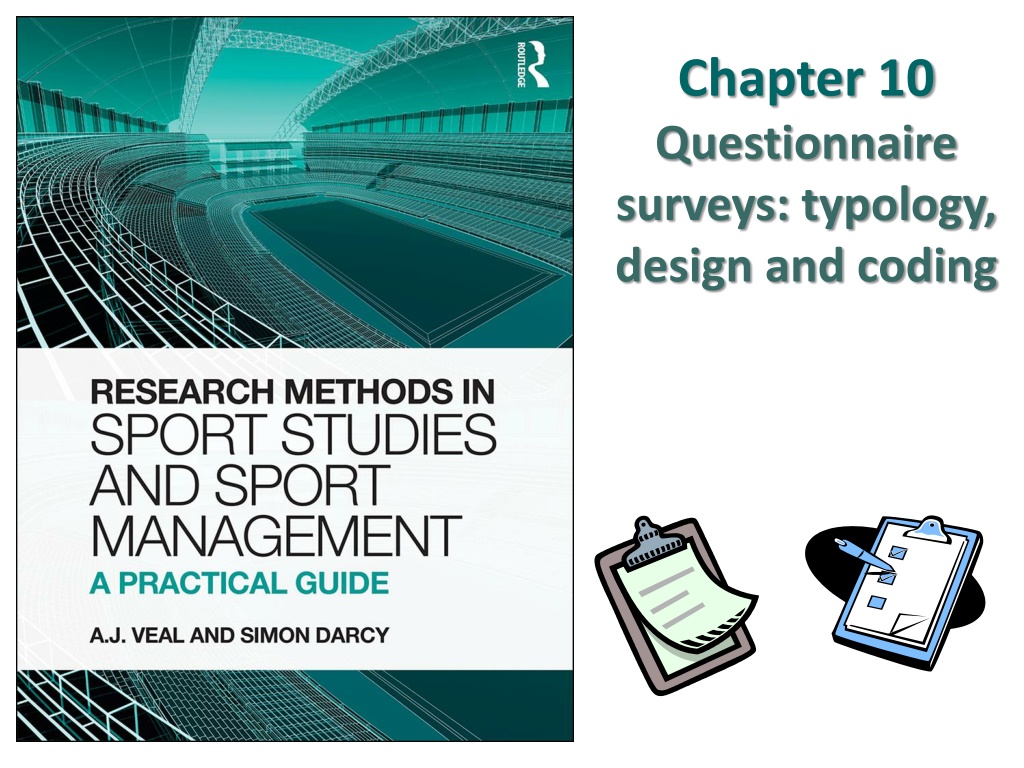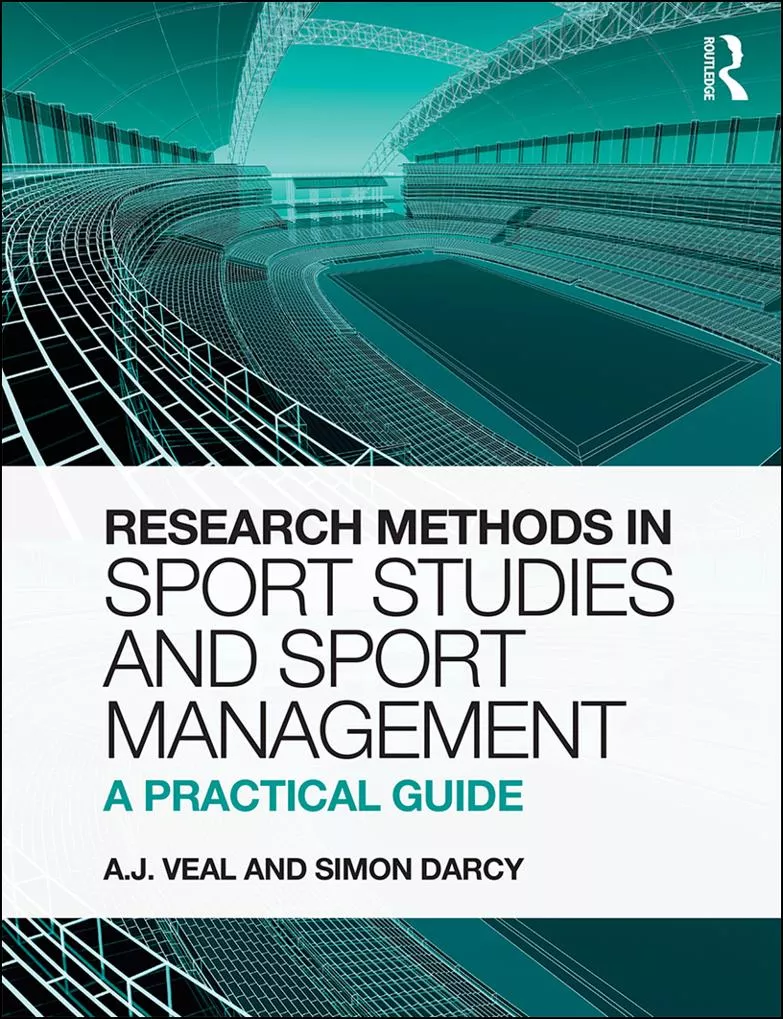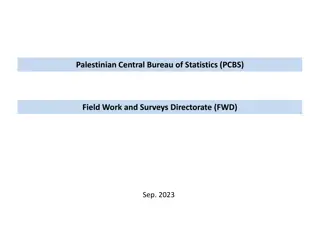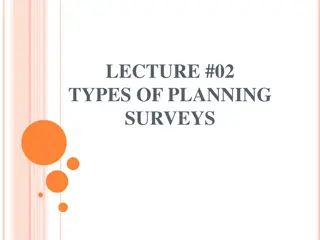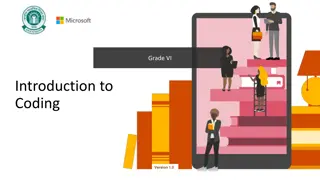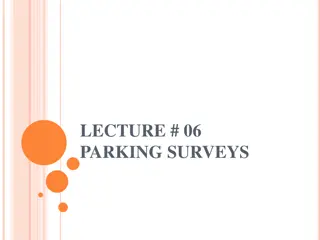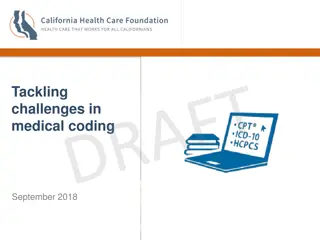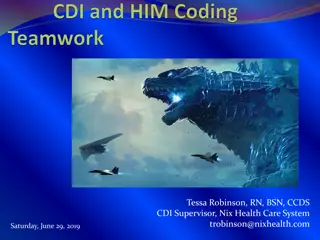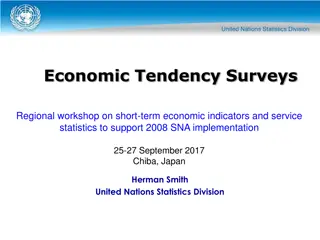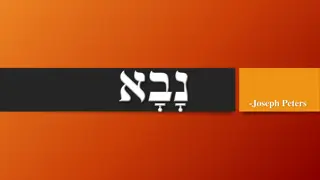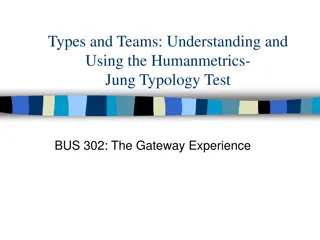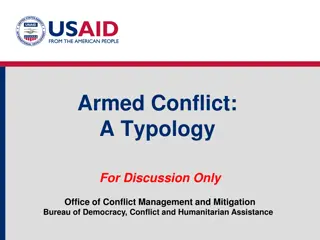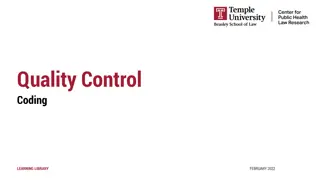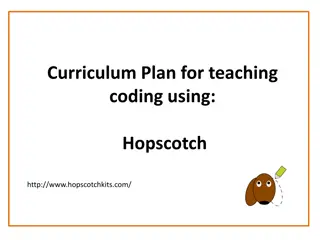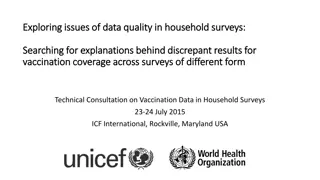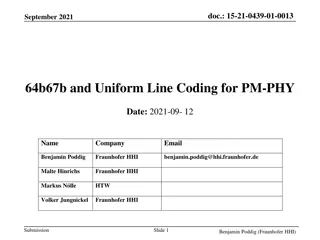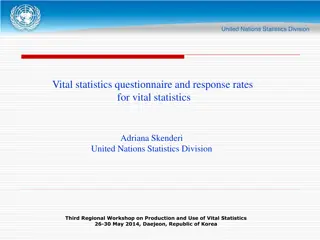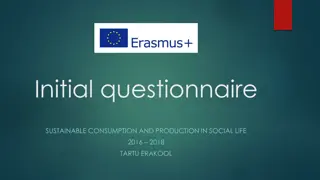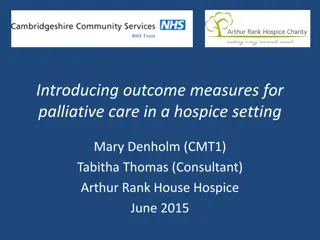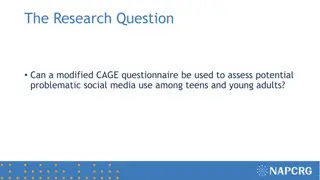Questionnaire Surveys: Typology, Design, and Coding
This content explores the world of questionnaire surveys, covering topics such as different types of surveys (household, street, telephone, mail, e-surveys, and more), questionnaire design, coding, validity of data, and the process of conducting questionnaire surveys. It delves into the definitions, roles, merits, and limitations of questionnaire surveys, providing insights into their importance and challenges in collecting data for various studies. The material discusses the role of questionnaire surveys in gathering information, the benefits of using them, and the potential drawbacks, such as self-reported data inaccuracies.
Uploaded on Sep 19, 2024 | 1 Views
Download Presentation

Please find below an Image/Link to download the presentation.
The content on the website is provided AS IS for your information and personal use only. It may not be sold, licensed, or shared on other websites without obtaining consent from the author.If you encounter any issues during the download, it is possible that the publisher has removed the file from their server.
You are allowed to download the files provided on this website for personal or commercial use, subject to the condition that they are used lawfully. All files are the property of their respective owners.
The content on the website is provided AS IS for your information and personal use only. It may not be sold, licensed, or shared on other websites without obtaining consent from the author.
E N D
Presentation Transcript
Chapter 10 Questionnaire surveys: typology, design and coding
CONTENTS Introduction The household questionnaire survey The street survey The telephone survey The mail survey E-surveys User/site/visitor surveys Captive group surveys Questionnaire design Coding Validity of questionnaire-based data Conducting questionnaire surveys
Introduction Definitions and terminology Roles Merits of questionnaire surveys Limitations Interviewer-completion or respondent-completion? Types of questionnaire survey A. J. Veal & S. Darcy (2014) Research Methods for Sport Studies and Sport Management: A practical guide. London: Routledge
Definitions Questionnaireor interview schedule : A printed or on-line list of questions Survey Whole process of conducting an investigation which involves a number of subjects Questionnaire survey A survey involving the use of a questionnaire ie. a survey is not a questionnaire A. J. Veal & S. Darcy (2014) Research Methods for Sport Studies and Sport Management: A practical guide. London: Routledge
Roles of questionnaire surveys Used when a specified range of information required Typically involve just a sample of the population being studied for implications see Ch. 13, Sampling But, the aim is to make inferred statements about the population as a whole A. J. Veal & S. Darcy (2014) Research Methods for Sport Studies and Sport Management: A practical guide. London: Routledge
Merits of questionnaire surveys An ideal method of providing policy-related data Transparent methodology Quantification easily communicated/understood Repeat surveys can study change over time Can cover a wide range of (sporting) activities Can study attitudes, meanings, perceptions of population as a whole A. J. Veal & S. Darcy (2014) Research Methods for Sport Studies and Sport Management: A practical guide. London: Routledge
Limitations of questionnaire surveys Samples see Ch. 13 Self-reported data exaggeration/under-reporting accuracy of recall sensitivity to some questions A. J. Veal & S. Darcy (2014) Research Methods for Sport Studies and Sport Management: A practical guide. London: Routledge
Interviewer-completion or respondent-completion? Interviewer-completion - More accuracy - Higher response rates - Fuller & more complete answers - Design can be less 'user- friendly' Respondent-completion - Cheaper - Quicker - Relatively anonymous Advantages Disadvantages - Higher cost - Patchy response - Incomplete response -Risk of frivolous responses - More care needed in design - Less anonymity A. J. Veal & S. Darcy (2014) Research Methods for Sport Studies and Sport Management: A practical guide. London: Routledge
Types of questionnaire survey (Fig. 10.3) Type Int. or resp. completion Cost Sample drawn from: Response rate Household Standard Either Time-use Resp. High High Whole popn* Whole popn* High High Omnibus Either Medium Whole popn* High * refers to population of subjects to be studied see ch. 13 A. J. Veal & S. Darcy (2014) Research Methods for Sport Studies and Sport Management: A practical guide. London: Routledge
Types of questionnaire survey contd (Fig. 10.3) Type Int. or resp. completion Interviewer Cost Sample drawn from Response rate Street Medium Most of pop n Medium Telephone Interviewer Medium People with land-line phone High but falling Mail Respondent Cheap General or Special Low A. J. Veal & S. Darcy (2014) Research Methods for Sport Studies and Sport Management: A practical guide. London: Routledge
Types of questionnaire survey contd (Fig. 10.3) Type Int. or resp. completion Respondent Cost Sample drawn from People access- ible via email/ internet Response rate E-survey Cheap Medium On-site Either Medium Site users only High Captive Respondent Cheap Captive group only High A. J. Veal & S. Darcy (2014) Research Methods for Sport Studies and Sport Management: A practical guide. London: Routledge
Household survey Nature Can cover all adult age-groups Representative of whole community Common for government, market research, etc. Conduct Typically interviewer-completed, but also drop-off and collect with respondent-completion sometimes used or combination Sampling see chapter 13 Omnibus surveys One questionnaire includes questions on a number of topics for multiple clients Time-budget studies Respondents complete a 1 or 2-day diary of activities National surveys See Chapter 7: often seen as secondary data sources A. J. Veal & S. Darcy (2014) Research Methods for Sport Studies and Sport Management: A practical guide. London: Routledge
Street surveys Nature Conducted in: Shopping street/mall Tourism areas (but may be seen as site survey ) Transport nodes (bus-stations, airports) - tourism Conduct Interviewers typically given quotas related to known demographics of the community Still a problems of representativeness re people who are housebound do not visit shopping streets do not visit particular tourist locations (eg. VFR sport tourists) A. J. Veal & S. Darcy (2014) Research Methods for Sport Studies and Sport Management: A practical guide. London: Routledge
Telephone survey Nature Common for political polling Growing response and representativeness problem because of: excluding those without land-line telephones growing resistance/non-response in some countries Conduct Fast, using CATI computer-aided telephone interviewing Numbers selected/dialed automatically Data keyed directly into computer Not possible to show checklists to respondents Anonymity may help honesty of response A. J. Veal & S. Darcy (2014) Research Methods for Sport Studies and Sport Management: A practical guide. London: Routledge
Mail/postal survey Nature Ideal for surveying widely dispersed lists eg. Members of organisations Conduct Low response rates eg. 30% often quoted as acceptable . but is it? Factors affecting response rates see below Mail and user/site survey combos In some on-site user/visitor surveys a brief face-to-face interview is combined with a hand-out questionnaire which respondents complete and mail back after their visit. A. J. Veal & S. Darcy (2014) Research Methods for Sport Studies and Sport Management: A practical guide. London: Routledge
Factors affecting mail survey response rates (Fig. 10.4) 1. Interest of the respondent in the survey topic 2. Length of the questionnaire 3. Questionnaire design/presentation/complexity 4. Style, content, authorship of accompanying letter 5. Provision of a postage-paid reply envelope 6. Rewards for responding 7. Number and timing of reminders/follow-ups see below A. J. Veal & S. Darcy (2014) Research Methods for Sport Studies and Sport Management: A practical guide. London: Routledge
Mail survey response pattern (Fig. 10.6) 80 70 Daily returns 70 60 Cumulative % 60 50 50 40 40 Reminder Card sent 30 Follow-up Letter sent 30 20 20 10 10 0 0 2 4 6 8 10 12 14 16 18 20 22 24 26 28 30 32 34 36 38 40 42 44 46 48 50 Days Start A. J. Veal & S. Darcy (2014) Research Methods for Sport Studies and Sport Management: A practical guide. London: Routledge
E-surveys Nature Conducted via email/Internet Dependent on availability of email list or other means of inviting sample to participate Conduct Partially or fully electronic Commercial organisations offer online service, including on-line questionnaire design, and analysis. Problem of response rate due to growth of junk mail A. J. Veal & S. Darcy (2014) Research Methods for Sport Studies and Sport Management: A practical guide. London: Routledge
Types of e-survey (Fig. 10.7) Type Hybrid email/mail Request Questionnaire Email Attached text file Completion Manual on hard copy Word-process- or/spreadsheet Return Mail Hybrid email Email Attached text file Email + text file On-line submission On-line submission Fully electronic: ad hoc Fully electronic: panel Email On-line, interactive Online Panel email On-line, interactive Online A. J. Veal & S. Darcy (2014) Research Methods for Sport Studies and Sport Management: A practical guide. London: Routledge
User/on-site/visitor surveys Nature Survey conducted at a leisure facility/site Alternative terms: On-site survey, site survey, user survey, visitor survey, spectator survey Commonly used by facility/site managers Conduct Interviewer completion preferred for quality/ response rate Respondent-completion, if not very closely supervised, can result in: Low response rates Unrepresentative sample Poor quality responses (incomplete etc.) On-site/mail combo face-to-face interview can be followed by handout of a mail-back questionnaire particularly in long-stay sites, such as cricket, golf match, motor sport A. J. Veal & S. Darcy (2014) Research Methods for Sport Studies and Sport Management: A practical guide. London: Routledge
Uses of User/on-site/visitor surveys Establish catchment area (place of residence) User profile (age, gender, socio-economic group etc.) User opinions Non-users : Use census data to assess non-users within the catchment area A. J. Veal & S. Darcy (2014) Research Methods for Sport Studies and Sport Management: A practical guide. London: Routledge
Captive group surveys Nature Respondents in organised group May have little choice but to participate Ethically, must be given the option Conduct Typically respondent-completed under supervision Quick and cheap A. J. Veal & S. Darcy (2014) Research Methods for Sport Studies and Sport Management: A practical guide. London: Routledge
Questionnaire design: Contents Introduction: research problems and information requirements Example questionnaires General design issues Types of information Activity/events/places questions Respondent characteristics Attitude/opinion questions Market segments Ordering of questions and layout of questionnaires A. J. Veal & S. Darcy (2014) Research Methods for Sport Studies and Sport Management: A practical guide. London: Routledge
Questionnaire design: culmination of a process (Fig. 10.8) Research questions/ management problem/ conceptual framework Research strategy List of information requirements Questionnaire survey Draft design Pilot/ test Final design Other methods? A. J. Veal & S. Darcy (2014) Research Methods for Sport Studies and Sport Management: A practical guide. London: Routledge
Example questionnaires: Case study 10.1 A. Questionnaire for a site/street survey: respondent- completed: Campus Sporting Life Survey B. Questionnaire for a household survey: interviewer- completed: Short-stay Sport Holiday Survey C. Questionnaire for a site survey: interviewer- completed: Ramsey Street Park Survey A. J. Veal & S. Darcy (2014) Research Methods for Sport Studies and Sport Management: A practical guide. London: Routledge
General design issues: wording of questions (Fig. 10.9) Principle Use simple language Bad example What is your frequency of utilisation of sport goods retailers? Improved version How often do you use sports shops? A. J. Veal & S. Darcy (2014) Research Methods for Sport Studies and Sport Management: A practical guide. London: Routledge
General design issues: wording of questions (Fig. 10.9) Principle Use simple language Bad example What is your frequency of utilisation of sport goods retailers? Do you play sport very often? Improved version How often do you use sports shops? Avoid ambiguity Have played any of the following sports within the last four weeks? (show list) A. J. Veal & S. Darcy (2014) Research Methods for Sport Studies and Sport Management: A practical guide. London: Routledge
General design issues: wording of questions (Fig. 10.9) Principle Use simple language Bad example What is your frequency of utilisation of sport goods retailers? Do you play sport very often? Improved version How often do you use sports shops? Avoid ambiguity Have played any of the following sports within the last four weeks? (show list) What is your opinion on the extension of the airport? Are you for it, against it or not concerned? Avoid leading questions Are you against the extension of the airport? A. J. Veal & S. Darcy (2014) Research Methods for Sport Studies and Sport Management: A practical guide. London: Routledge
General design issues: wording of questions (Fig. 10.9) Principle Use simple language Bad example What is your frequency of utilisation of sport goods retailers? Do you play sport very often? Improved version How often do you use sports shops? Avoid ambiguity Have played any of the following sports within the last four weeks? (show list) What is your opinion on the extension of the airport? Are you for it, against it or not concerned? 1. Do you use the local sports centre? Yes/No 2. What do you think of the facilities in the local sports centre? Avoid leading questions Are you against the extension of the airport? Ask just one question at a time. Do you use the local sports centre, and if so what do you think of its facilities? A. J. Veal & S. Darcy (2014) Research Methods for Sport Studies and Sport Management: A practical guide. London: Routledge
Pre-coded vs open-ended questions (Fig. 10.10) Open-ended: What is the main constraint on your ability to study? ________________________________________ Pre-coded/closed: A. My job B. Timetabling C. Child care D. Spouse/partner E. Money F. Energy G. Other ____________ 7 1 2 3 4 5 6 In interview situation card shown to interviewee A. J. Veal & S. Darcy (2014) Research Methods for Sport Studies and Sport Management: A practical guide. London: Routledge
Open-ended questions produce large numbers of answers (Fig. 10.11), which will require coding (see later) Question: Do you have any complaints about this (beach/picnic) area? (Site survey in a beachside National Park with boating and camping. Number of responses in brackets) Sand bars (22) - Uncontrolled boats (23) Parking (5) - Jet skis (39) Wild car driving (1) - Surveys (1) Lack of beach area (1) - Should be kept for locals (1) Too few shops (1) - Seaweed (3) Too few picnic tables (4) - Need showers (1) No timber for barbecue (2) - Administration of National Park (1) Need more picnic space (3) - Maintenance & policing of Park (1) Need boat hire facilities (1) - Trucks on beach (2) Need active recn facilities (1) - Anglers (1) Litter/pollution (74) - Crowds/tourists (26) Urban sprawl (1) - Having to pay entry fee (6) Need wharf fishing access (1) - Houses along waterfront (2) Lack of info. on walking trails (1) - Unpleasant smell (drain) (2) Not enough facilities (3) - Sales people (1) Slow barbecues (2) - Need electric barbecues (1) Etc. - Etc A. J. Veal & S. Darcy (2014) Research Methods for Sport Studies and Sport Management: A practical guide. London: Routledge
Types of information 1. Activities/events/places 2. Respondent characteristics 3. Attitudes/motivations What? Who? Why? A. J. Veal & S. Darcy (2014) Research Methods for Sport Studies and Sport Management: A practical guide. London: Routledge
Activity/event/places questions Effect of participation reference period See Table 10.1 A. J. Veal & S. Darcy (2014) Research Methods for Sport Studies and Sport Management: A practical guide. London: Routledge
Participation in sport etc. by reference period, Britain, 1987: Table 10.1 (part) % of persons aged 16+ participating in last: A. year B. 4 weeks 68.2 35.1 14.9 20.7 2.6 Ratio of A:B 1.5 2.7 5.1 1.7 8.7 Walking Swimming: indoors Swimming: outdoor Keep fit/yoga Skiing 44.5 12.8 2.9 12.3 0.3 A. J. Veal & S. Darcy (2014) Research Methods for Sport Studies and Sport Management: A practical guide. London: Routledge
Respondent characteristics: range of data Marital/family status Household type/family size Life-cycle Ethnic group/country of birth Residential location Mobility - driving licence, access to private transport Party/group size/type (site/visitor surveys) Gender Age Economic status Occupation/social class (own or 'head of household') Previous job history Income (own or household) Education/qualifications A. J. Veal & S. Darcy (2014) Research Methods for Sport Studies and Sport Management: A practical guide. London: Routledge
Attitude/opinion questions Formats a. Open-ended or direct questions b.Checklist c. Ranking d.Likert scales e.Attitude statements f. Semantic differential g. Repertory grid A. J. Veal & S. Darcy (2014) Research Methods for Sport Studies and Sport Management: A practical guide. London: Routledge
Attitude/opinion questions contd (Fig. 10.17) a. Open-ended/direct: What attracted you to apply for this course? ____________________________________ b. Checklist: Of the items on the card, which was the most important to you in applying for this course? A. Good reputation B. Easy access C. Curriculum D. Level of fees E. Easy parking A. J. Veal & S. Darcy (2014) Research Methods for Sport Studies and Sport Management: A practical guide. London: Routledge
Attitude/opinion questions contd (Fig. 10.17) c. Ranking: Please rank the items on the card in terms of their importance to you in choosing a course. Please rank them 1 for the most important to 5 for the least important. Rank A. Good reputation ___ B. Easy access ___ C. Curriculum ___ D. Level of fees ___ E. Easy parking ___ A. J. Veal & S. Darcy (2014) Research Methods for Sport Studies and Sport Management: A practical guide. London: Routledge
Attitude/opinion questions contd (Fig. 10.17) d. Likert scales: Looking at the items on the card, please say how important each was to you in choosing this course; was it: Very important, Quite important, Not very important or Not at all important? Very Quite important important important important Good reputation 1 Easy Access 1 Curriculum 1 Level of fees 1 Easy parking 1 Not very Not at all 2 2 2 2 3 3 3 3 4 4 4 4 2 3 4 A. J. Veal & S. Darcy (2014) Research Methods for Sport Studies and Sport Management: A practical guide. London: Routledge
Attitude/opinion questions contd (Fig. 10.17) e. Attitude Statements: Please read the statements below and indicate your level of agreement or disagreement with them by ticking the appropriate box. Agree Agree No Strongly The learning experience is more important than the qualification in education 1 2 3 Disagree Disagree opinion strongly 4 5 Graduate course fees are too high 1 2 3 4 5 A. J. Veal & S. Darcy (2014) Research Methods for Sport Studies and Sport Management: A practical guide. London: Routledge
Attitude/opinion questions contd (Fig. 10.17) f. Semantic differential: Please look at the list below and tick the line to indicate where you think this course falls in relation to each factor listed. Difficult |_______|________|________|________| Easy Irrelevant |_______|________|________|________| Relevant Professional |_______|________|________|________| Unprofessional Dull |_______|________|________|________| Interesting A. J. Veal & S. Darcy (2014) Research Methods for Sport Studies and Sport Management: A practical guide. London: Routledge
Introductory remarks, Ordering of questions Consider content/length of opening/introductory remarks Question order: Start with easy questions Start with 'relevant' questions Leave sensitive questions until later Layout: Be aware of the needs of the reader/user interviewer or respondent? Special care with mail survey questionnaires Compactness (eg. single page) = ease of handling Two-column layout often helps A. J. Veal & S. Darcy (2014) Research Methods for Sport Studies and Sport Management: A practical guide. London: Routledge
Coding Giving numerical codes to answers: eg. Yes: 1 No: 0 alpha codes can be used, but numeric has advantages Coding of open-ended questions: Fig. 10.19 A. J. Veal & S. Darcy (2014) Research Methods for Sport Studies and Sport Management: A practical guide. London: Routledge
Answers from 25 respondents to the question: 'What suggestions would you make for improving campus sporting life? (Fig. 10.19) More sport available /// Upgrade gym facilities /// More weekday events // More lunch-time events / More evening events // Better music in gym / Cheaper drinks /// Free transport from city / Better food /// Keep out non-students // Better spectator accommodation /// Better coaches/instructors // More classes for women // Lower membership costs // Warmer pool water // Better control of facility users // Suggested coding system code Comments on programme content 1 Comments on timing Comments on facilities Comments on costs Comments on organisation Other 2 3 4 5 6 A. J. Veal & S. Darcy (2014) Research Methods for Sport Studies and Sport Management: A practical guide. London: Routledge
Recording coded information (Fig. 10.20) Campus Sporting Life Survey 2008 1. Which of the following best describes your current situation? Full-time student with no regular paid work Full-time student with some regular paid work Part-time student with full-time job Part-time student - other 1 2 3 4 | Office Use | # 1 | qno | | | 2status | | ONLY ONE ANSWER POSSIBLE ONE CODE ONE VARIABLE (status) A. J. Veal & S. Darcy (2014) Research Methods for Sport Studies and Sport Management: A practical guide. London: Routledge
Recording coded information contd 2. Which of the following university sport facilities have you used in the last 4 weeks? Swimming pool Gym Squash courts Attended sports match a spectator UP TO FOUR POSITIVE ANSWERS POSSIBLE FOUR VARIABLES | Office use | | | 1 cafebar | 1 music | 0 sport | 0 travel | 1 1 1 1 A. J. Veal & S. Darcy (2014) Research Methods for Sport Studies and Sport Management: A practical guide. London: Routledge
Recording coded information contd 3. In thinking about the sport and social services provided on campus, | what are the most important considerations for you? Please rank the items below in terms of their importance to you. Rank them from1 for the most important to 5 for the least important. | Free or cheap access Convenient opening hours Quality of facilities Opportunities to socialise/meet people Available time | | Rank 1 4 2 3 5 | | 1 cheap | 4 daytime | 2unusual | 3 meet | 5 quality | FIVE RANKS REQUIRED FIVE VARIABLES A. J. Veal & S. Darcy (2014) Research Methods for Sport Studies and Sport Management: A practical guide. London: Routledge
Recording coded information contd 4. Approximately how much do you spend in an average month on sport and social activities on and off campus? NUMBER RECORDED 5. Please indicate the importance of the following to you in relation to campus life. Very important Relaxation opportunities 1 Social interaction 1 Fitness 1 | | 3 relax | 3 social | 1 mental | | 100 | | 100 spend | | | | | | Important Not at all important 3 3 3 2 2 2 THREE ANSWERS REQUIRED THREE VARIABLES A. J. Veal & S. Darcy (2014) Research Methods for Sport Studies and Sport Management: A practical guide. London: Routledge
Recording coded information contd 6. What suggestions would you make for improving campus social life? | Provide more flunchtime sessions___ _________________ ________________________________________________ ________________________________________ OPEN-ENDED (CODING SEE Fig. 10.19) UP TO THREE ANSWERS RECORDED = THREE VARIABLES 7. You are: Male 1 Female 2 8. Your age last birthday was: 22 years | | 1 sug1 | __ sug2 | __ sug3 | | | | 2 gender | | 22 age | A. J. Veal & S. Darcy (2014) Research Methods for Sport Studies and Sport Management: A practical guide. London: Routledge
Data from first completed questionnaire (Fig. 10.21) Variables qno status cafebar music sport travel cheap daytme unusual meet quality spend relax social mental sug1 sug2 sug3 gend age 1 2 1 1 0 0 1 4 2 3 5 100 3 3 1 1 1 18 Data from one questionnaire (as in Fig 10.20) A. J. Veal & S. Darcy (2014) Research Methods for Sport Studies and Sport Management: A practical guide. London: Routledge
